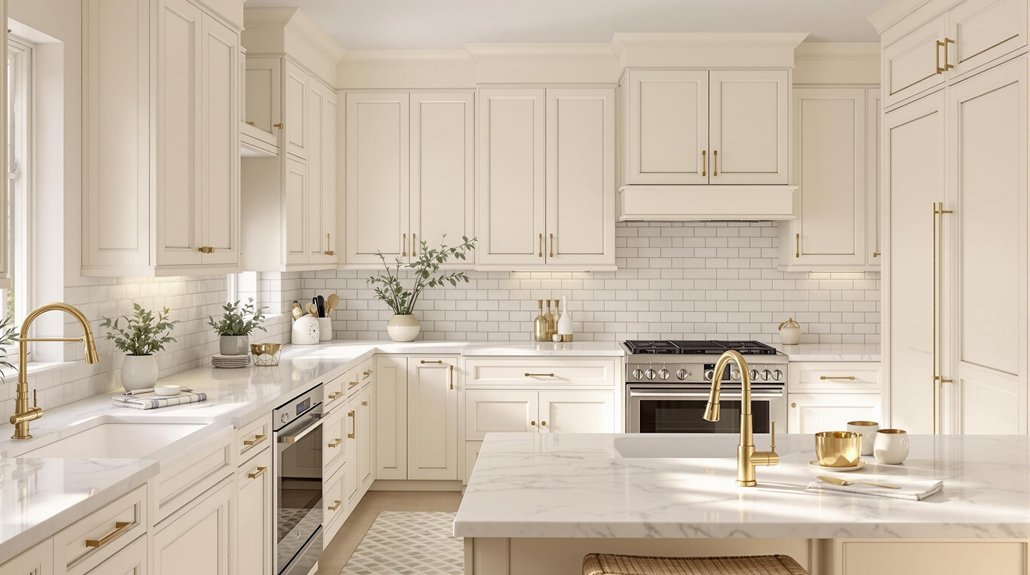
15 Cream Kitchen Colour Schemes That Are Soft and Sophisticated
Cream kitchen colour schemes blend warm neutrality and luminous sophistication, forming an adaptable base for design statements. Options span from earthy textures with timber and tan, elegant contrasts via teal or navy, to playful mint accents and lively patterned tiles. Monochrome layers in varying creams build depth, while touches of greenery and rustic wood evoke inviting energy. Strategic mirrors and art infuse additional dimension. Explore numerous combinations to create a kitchen that is refined, vibrant, and distinctively your own.
Key Takeaways
- Pair cream walls with deep-hued cabinetry and natural wood elements for a warm, harmonious kitchen atmosphere.
- Introduce teal, blue, or orange accents through tiles, decor, or cabinetry for dynamic contrast and visual interest.
- Layer cream tones with matte and glossy finishes to create depth and tactile sophistication in a monochrome palette.
- Incorporate greenery, botanical art, or rustic farmhouse details to enhance invitation and authenticity in cream kitchens.
- Add statement lighting, mirrors, and curated art to elevate the elegance and perceived spaciousness of cream kitchen schemes.
A Careful Balance
A careful balance defines the essence of cream kitchen colour schemes, where cream wall paint amplifies ambient brightness and counterbalances deeper cabinetry hues to achieve visual harmony.
Expertly chosen cream kitchen cabinets serve as a neutral anchor within the colour palette, allowing for seamless integration of natural elements such as wooden textures and subtle stone surfaces.
Cream kitchen cabinets act as a neutral foundation, effortlessly pairing with wood accents and gentle stone finishes for timeless elegance.
These design choices introduce an organic dimension that enhances the overall inviting feel of the space.
Soft hues in the cream spectrum foster a cohesive flow, making the kitchen both welcoming and visually expansive.
The strategic placement of greenery and curated art further boosts the aesthetic, infusing the environment with energy and creativity.
Ultimately, the thoughtful interplay of these elements crafts a refined and sophisticated kitchen atmosphere.
Down to Earth
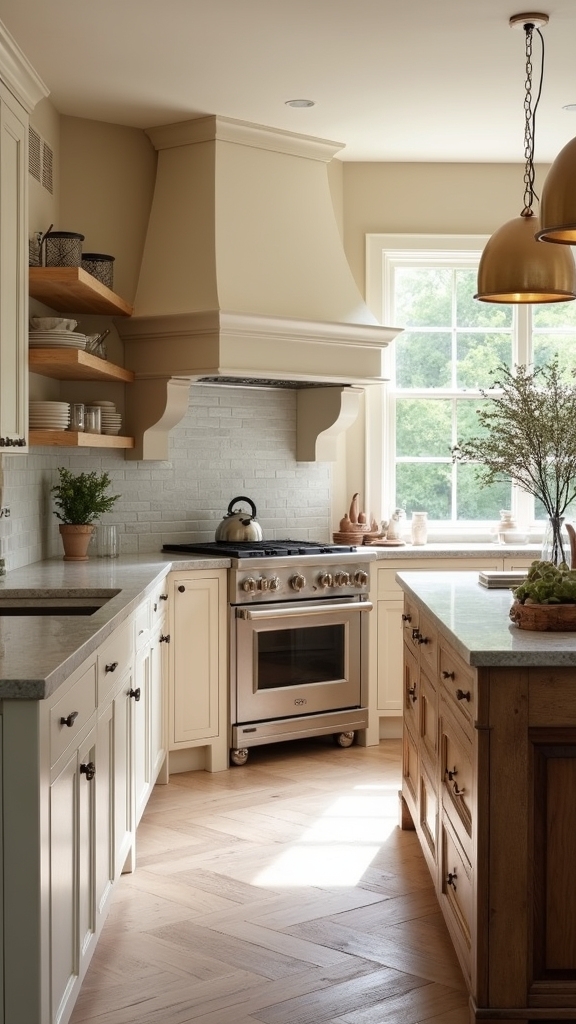
Building on the interplay of cream tones with natural textures, the “Down to Earth” approach foregrounds the synergy between creamy hues and earthy materials.
In cream kitchen colour schemes, the integration of warm undertones and natural materials, such as wooden counters and accessories in earthy tones, fosters an inviting space that feels both grounded and refined.
Subtle layering with cream paint and tile enriches wall surfaces, adding dimension without visual clutter.
The neutral palette, when juxtaposed with bolder units in deep green, maintains equilibrium while celebrating organic inspiration.
This design rationale leverages the inherent harmony between creams and earthy tones, producing a timeless environment that is soothing yet sophisticated, and ultimately enhances the kitchen’s role as a hub for relaxation, creativity, and convivial gatherings.
If It Teals Right
Teal accents introduce dynamic contrast to cream kitchens, punctuating the palette with saturated color and visual energy.
The interplay between cream, teal, and blue is carefully calibrated to maintain both cohesion and spatial warmth.
This balanced approach transforms neutral spaces into design-forward environments with pronounced focal points and contemporary flair.
Teal Accents for Contrast
Frequently, designers employ teal accents in cream kitchens to introduce a vibrant yet grounded contrast, optimizing visual interest without compromising spatial harmony.
The interplay between cream cabinetry and teal accents is deliberate, utilizing both colour theory and spatial dynamics to enhance sophistication. Teal’s earthy undertones complement the warmth of cream, evoking a calming, contemporary environment.
Strategic application is essential, ensuring that teal functions as a visual anchor rather than an overwhelming force. Key methods include:
- Integrating teal backsplash tiles to create immediate focal points.
- Selecting teal decorative elements—such as vases or bar stools—for subtle contrast.
- Utilizing teal pendant lighting to highlight work surfaces and uplift ambience.
- Incorporating teal in window treatments or textiles to infuse personality while preserving the kitchen’s bright, airy quality.
Balancing Cream and Blue
When carefully orchestrated, the interplay between cream cabinetry and blue accents establishes a dynamic yet serene foundation for kitchen design. Blue accents, especially in earthy blue-grey tones, provide a compelling contrast to the warmth of cream cabinetry, yielding a sophisticated color palette with visual depth. Teal and light blue infusions—whether through backsplash tiles or decorative elements—invite personality while retaining cohesion. The strategic use of natural materials, such as wooden countertops, further enhances the organic synergy of the scheme, fostering both tranquility and vibrancy.
| Element | Function | Visual Impact |
|---|---|---|
| Cream cabinetry | Foundation | Warm, timeless |
| Blue accents | Contrast & emphasis | Striking, contemporary |
| Natural materials | Texture & harmony | Organic, calming |
The combination guarantees modern elegance adaptable to diverse kitchen styles.
Farmhouse Feels
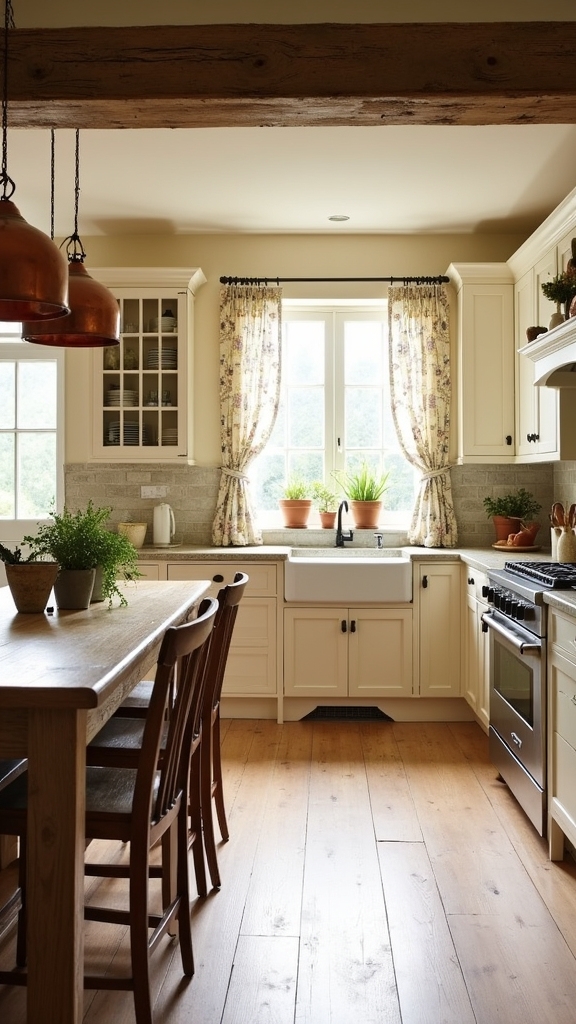
Farmhouse-inspired cream kitchens achieve their signature warmth and authenticity through a careful interplay of materials and light.
This design ethos draws upon classic elements while ensuring the space feels both airy and open. The farmhouse ambiance is cultivated by the strategic selection and arrangement of natural materials, as well as the integration of timeless features. Incorporating reclaimed wood in cabinetry or flooring adds unique grain patterns and a weathered texture, enhancing the farmhouse charm and authenticity.
Key design principles include:
- Rustic Wooden Floors: Natural timber underfoot grounds the room, imparting a sense of history and durability.
- Bright Cream Walls: These maximize daylight reflection, heightening the kitchen’s luminosity and sense of space.
- Skylight Integration: Purposeful use of overhead light sources enhances openness and infuses the interior with a cheerful atmosphere.
- Shaker-Style Cabinets: Traditional cabinetry profiles reinforce the classic farmhouse aesthetic, blending elegance with practical functionality.
Neutral Colour Pops

Building upon the grounded warmth of farmhouse design, neutral colour pops introduce refined visual accents that invigorate cream kitchen schemes without overwhelming their subtlety.
Strategic paint layering in neutral shades—taupe, greige, or soft charcoal—creates depth and dimension alongside classic cream cabinets. Wall murals applied with stencils offer an opportunity for personal touches, delivering bespoke patterns that distinguish the space.
Layering neutrals and adding bespoke stenciled murals brings depth and personal character to timeless cream kitchen cabinetry.
Greige cabinets seamlessly blend with various design styles, ensuring timeless appeal. Adjacent lighting fixtures, such as pendant lights or under-cabinet LEDs, are instrumental in spotlighting these curated elements, enhancing the interplay of complementary colors. Hanging plants provide a subtle injection of energy, their organic textures harmonizing with the sophisticated neutrality.
Artworks or decorative accessories in muted or contrasting hues further enhance the environment, achieving a balance between warmth, individuality, and cohesive design integrity.
Contemporary Creams
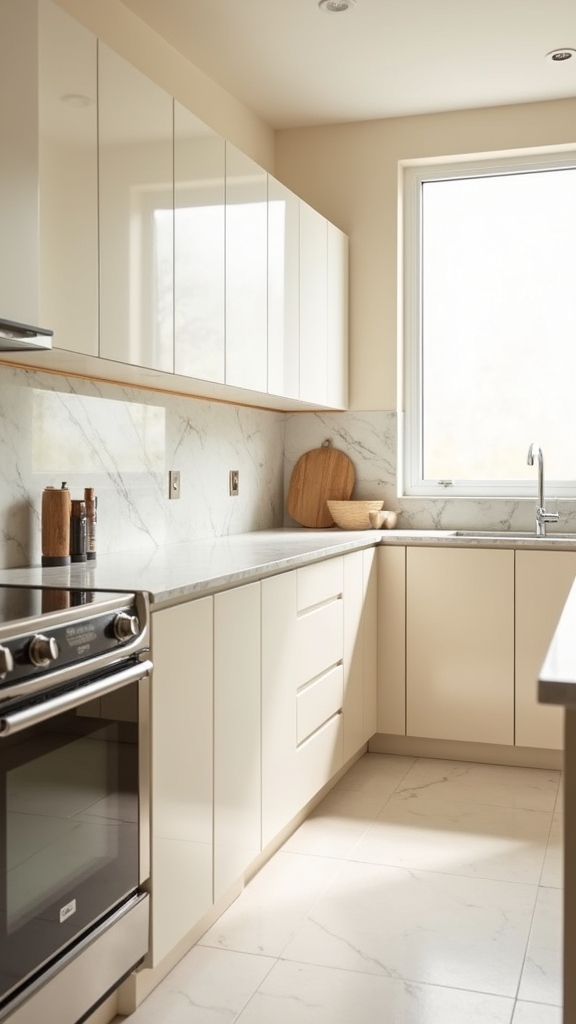
A multitude of contemporary cream kitchens leverage the versatility of this hue as a sophisticated canvas for modern design elements. Cream units establish a light and airy foundation, balancing warmth with a clean, uncluttered aesthetic.
The application of contemporary design principles is evident in the interplay of materials and details:
- Cream units paired with black metro tiles create high visual contrast and a practical, wipe-clean surface.
- Granite worktops introduce a durable, tactile counterpoint, enhancing the modern style’s functional edge.
- Statement glass pendant lights and wireframe barstools infuse elegance and sculptural presence.
- Pale flagstone flooring amplifies spatial brightness while grounding the scheme.
Shaker-style cabinets and cream wall tiles further reinforce this modern-classic fusion, making the style adaptable for both urban apartments and low-ceilinged cottages.
Stylish Blue Accents
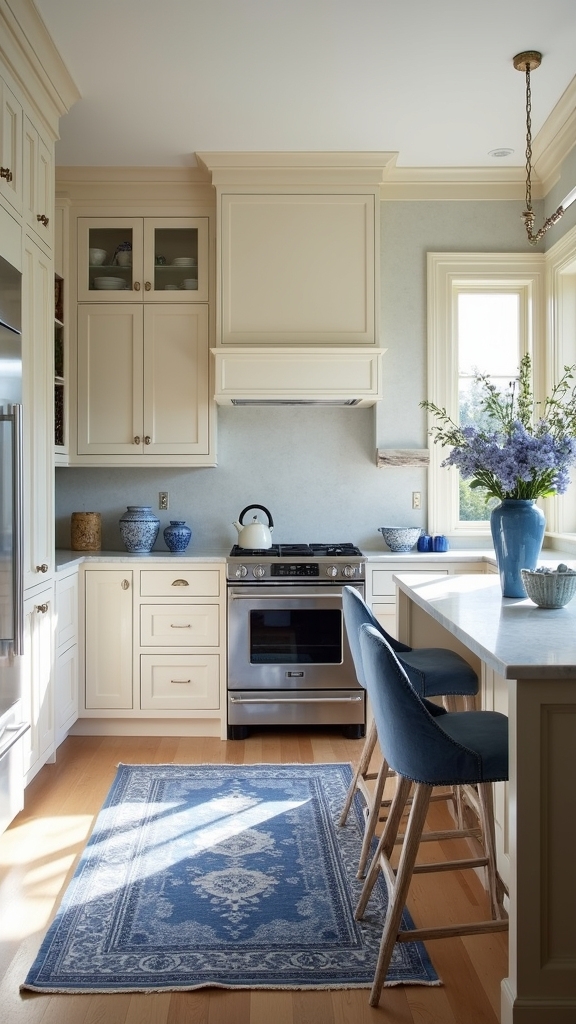
Integrating blue cabinets introduces a bold contrast against cream backdrops, establishing a dynamic focal point within the kitchen.
Teal accessories, strategically placed, infuse warmth and reinforce the inviting character of the space.
This layered approach balances vibrancy and tranquility, ensuring the design remains cohesive and visually engaging.
Blue Cabinets for Contrast
When paired with cream units, blue cabinets introduce a striking visual counterpoint that enhances a kitchen’s aesthetic sophistication.
The interplay between cream and blue cabinets delivers a harmonious balance, merging warmth with a rejuvenating touch of modernity. Designers leverage this contrast for both visual impact and atmospheric calm, creating a kitchen space that feels inviting yet distinctly contemporary.
Consider these expert recommendations for integrating blue cabinets with cream tones:
- Opt for deep navy hues to anchor the kitchen and draw the eye, establishing a clear focal point.
- Use pastel blues for a softer contrast, maintaining cohesion with cream while adding subtle depth.
- Accent with blue bar stools or decor for layered sophistication without overpowering the cream backdrop.
- Adopt current design trends by mixing matte and gloss finishes, elevating the overall visual texture.
Teal Accessories Enhance Warmth
Teal accents infuse cream kitchens with a sophisticated vibrancy, delivering a dynamic yet balanced interplay of color. This combination introduces a refined contrast, where teal accessories—such as pendant lamps, bar stools, or small appliances—serve as deliberate focal points against the neutral backdrop of cream cabinetry.
The warmth of the cream kitchen is magnified by teal’s cool undertones, resulting in a harmonious visual equilibrium that is both inviting and contemporary. Teal’s affinity for earthy shades guarantees that the space remains grounded, while its vivid hue injects personality and charm without overwhelming the palette.
As a design strategy, using teal accents creates visual interest and cohesion, making the kitchen feel modern, fresh, and thoughtfully curated. This synergy is ideal for contemporary interiors seeking subtle sophistication.
Monochrome Magic
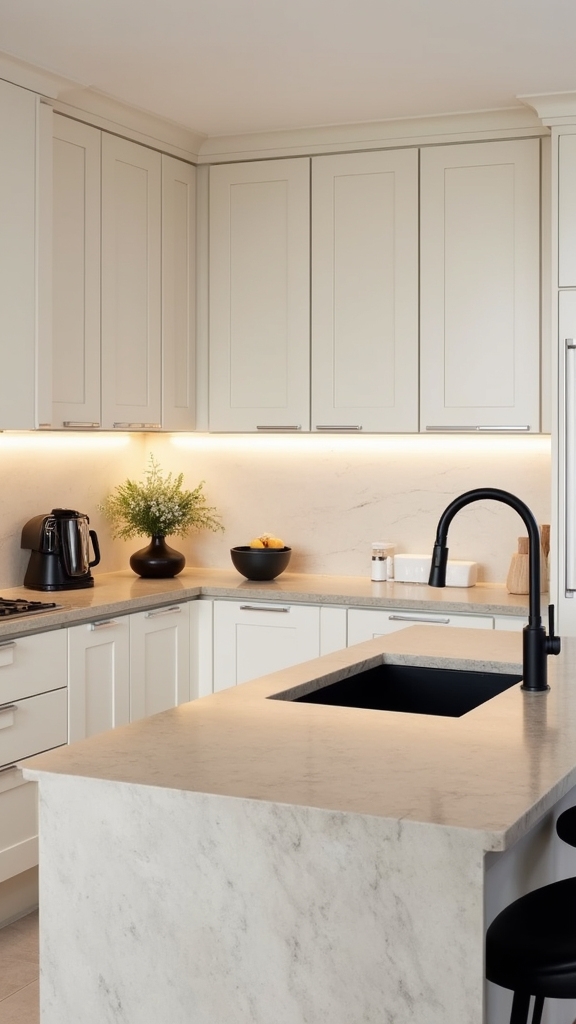
Although often understated, monochrome color schemes in cream kitchens deliver a seamless and sophisticated aesthetic by layering varying shades of cream and off-white. This approach amplifies spatial perception and maximizes natural light, rendering the kitchen both expansive and tranquil.
The strategic use of a monochrome palette can be enhanced through nuanced design choices, as follows:
- Cream cabinetry forms the foundation, providing visual unity and a soft, inviting backdrop.
- Layered effect is achieved by combining countertops and backsplashes in lighter or darker creams, contributing to depth without disrupting cohesion.
- Textural diversity—matte and glossy finishes—enhances tactile interest while maintaining chromatic harmony.
- Metallic accents, such as subtle brass or copper hardware, introduce understated elegance, complementing the serenity of soft beige tones.
This method guarantees enduring sophistication and timeless appeal.
A Twist of Orange
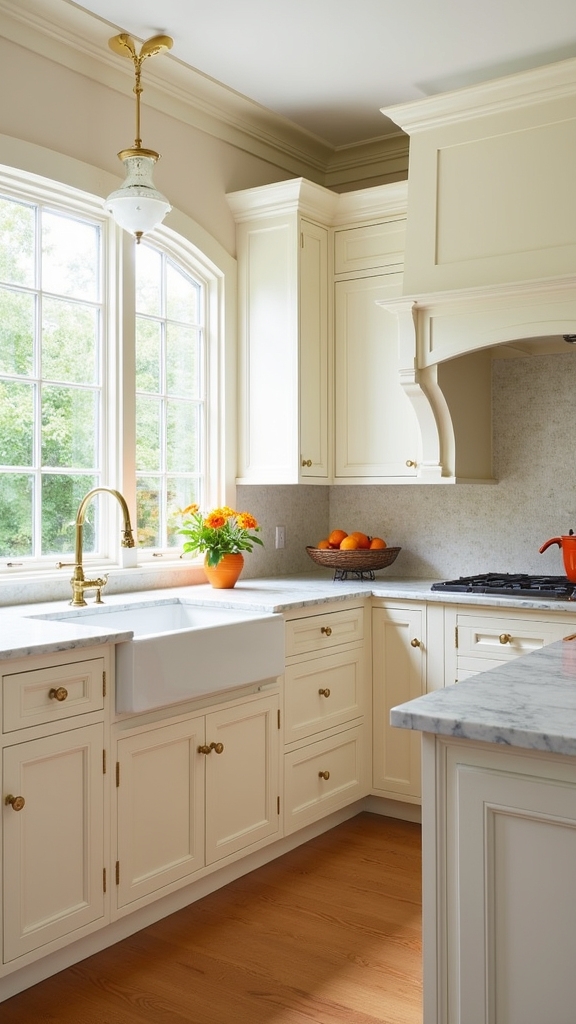
Vibrancy defines the union of cream and orange in contemporary kitchen design, where strategic pops of orange invigorate the neutral palette without overwhelming it.
Within a cream kitchen, orange accents—ranging from pendant lights to small appliances—deliver deliberate focal points that heighten visual interest and spatial energy.
Two-tone cabinetry, with cream as the primary and orange as an accent, introduces a modern dynamic while maintaining a cohesive, inviting aesthetic. This calculated juxtaposition amplifies warmth, ensuring the space feels approachable yet refined.
Earthy orange tones seamlessly complement natural wood finishes and other warm hues, fostering an environment conducive to convivial gatherings.
The result is a cream kitchen that balances sophistication with a lively, cheerful undertone—ideal for both everyday living and entertaining.
Playful Patterns

Geometric tiles and whimsical wallpapers introduce expressive pattern into cream kitchen colour schemes, infusing the space with visual intrigue while preserving its refined ambiance.
Designers leverage playful patterns to soften the monochromatic tendencies of cream kitchens, resulting in spaces that are both sophisticated and lively.
Playful patterns enliven cream kitchens, transforming monochrome spaces into environments that exude both elegance and inviting warmth.
Strategic use of pattern amplifies visual interest and depth, while careful selection of textures and lighting fixtures guarantees cohesion.
Consider the following expert recommendations:
- Install geometric tiles as a backsplash to create a subtle yet dynamic focal point.
- Choose patterned textiles—curtains, rugs, or seat cushions—to introduce layered textures without disrupting the cream palette.
- Feature a bold patterned wall with mural or stencil work for a strong visual anchor.
- Integrate lighting fixtures with playful designs, enhancing ambience and sculptural interest.
Hey Jade

The “Hey Jade” approach highlights the impact of curated accents in cream kitchens, using personalized décor elements to reflect individual style. Strategically placed artwork and botanical installations enhance the ambience, infusing visual interest and biophilic appeal. These layered details foster a welcoming environment, reinforcing both character and comfort within the cream palette. Incorporating colorful backdrops behind shelves can add personality and visual appeal, creating vibrant focal points that complement the cream color scheme.
Personalized Cream Kitchen Accents
Several distinctive accent choices can enhance a cream kitchen from understated to visually dynamic.
Personalized details inject individuality and uplift the neutral palette with curated touches. Expert designers utilize these strategies to add colour, depth, and warmth:
- Vibrant Colour Pops: Introducing bold hues—such as fuchsia pendant lights or statement artwork—creates focal points and invigorates the creamy backdrop.
- Textile Layering: Curtains, runners, and rugs in complementary tones or subtle patterns bring tactile depth, softening the environment and increasing warmth.
- Freestanding Furniture: Painted cream sideboards or farmhouse tables offer functional storage and a bespoke, welcoming effect—ideal for flexible layouts.
- Botanical Displays: Houseplants in decorative pots infuse organic vibrancy, contrasting the cream kitchen’s surfaces and reinforcing a personalized, natural aesthetic.
These design elements forge a sophisticated, inviting space.
Enhancing Ambience With Art
Beyond personalized accents, art emerges as a powerful tool for shaping the atmosphere within a cream kitchen. Expertly chosen artwork introduces layers of visual interest, serving as intentional focal points that draw the eye and define spatial hierarchy.
Employing complementary colors—such as earthy greens or vibrant teals—within these pieces enlivens the neutral backdrop, achieving a harmonious palette that feels both curated and dynamic. Wall murals or stencils offer bespoke design narratives, elevating flat surfaces with dimension and texture.
The strategic placement of such artwork not only enhances ambiance but also guarantees the kitchen remains cohesive; each element is purposefully integrated to reinforce the overall aesthetic.
Ultimately, investing in art transforms a cream kitchen from simply functional to a sophisticated, visually engaging environment.
Greenery for Inviting Energy
Introducing greenery into a cream kitchen activates a dynamic interplay between organic elements and neutral foundations, cultivating an environment that feels both invigorating and serene.
The integration of natural elements infuses the space with inviting energy, optimizing the harmonious palette of cream cabinetry and subtle undertones.
For a visually compelling and functionally enriched kitchen, designers recommend:
- Placing potted herbs or verdant houseplants to enhance air quality and visual intrigue.
- Using botanical-themed art to echo natural elements and amplify inspiration.
- Creating focal points with hanging greenery or vertical gardens, providing structural balance to cream surfaces.
- Selecting plant containers in complementary hues to reinforce cohesion within the palette.
This strategic application of greenery yields a sophisticated, health-promoting space, while sustaining the timeless elegance inherent in a cream kitchen.
Minty Fresh
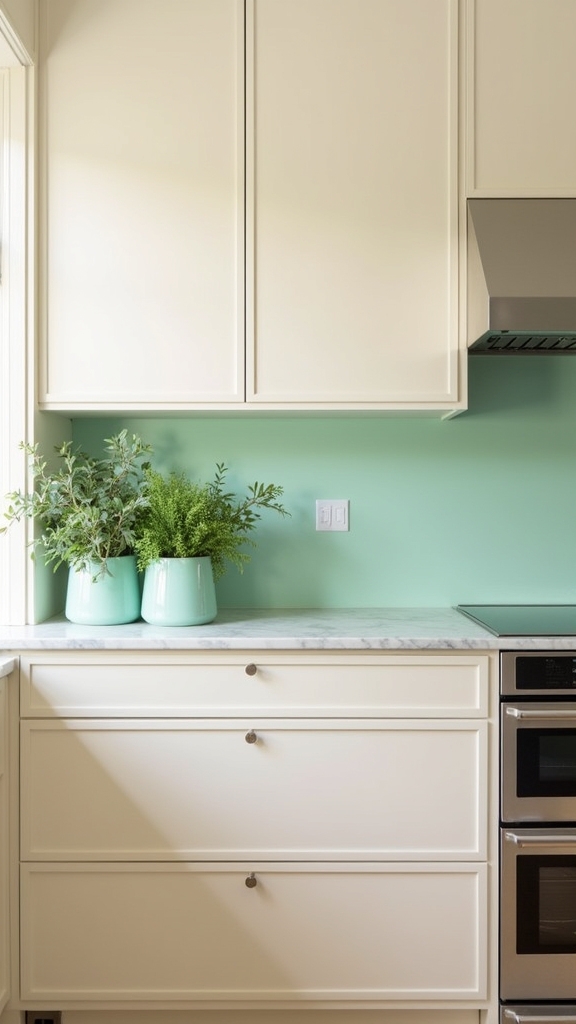
A touch of mint green introduces a crisp, contemporary edge to cream kitchen colour schemes, delivering a subtle yet invigorating contrast.
This nuanced interplay raises cream kitchens, where mint green serves as both a visual refresh and an anchor for a soothing atmosphere. Designers often employ mint green in cabinetry or wall accents, deftly establishing focal points that draw the eye without overwhelming the space.
Mint’s gentle vibrancy pairs harmoniously with natural elements—such as timber countertops or rattan accessories—enhancing the organic dimension of the kitchen’s aesthetic. Accessories in mint, from dishware to textiles, infuse playful sophistication while maintaining cohesion with cream’s soft undertones.
The result is a balanced, light-filled environment, defined by serenity and understated elegance through expertly curated colour placement.
Tan-tastic

Shifting from mint’s invigorating coolness, tan emerges as an ideal partner to cream in kitchen colour schemes, imparting warmth and visual depth without disrupting the scheme’s inherent sophistication.
Tan’s gentle warmth enriches cream kitchens, adding depth and elegance while preserving a refined, sophisticated atmosphere.
When deployed thoughtfully, tan tones enhance the cream kitchen, reinforcing a sophisticated aesthetic and ensuring timeless elegance.
Strategic integration of tan achieves a harmonious balance between organic comfort and visual interest.
Designers often recommend the following approaches:
- Pair cream cabinetry with tan wooden accents to create tactile warmth and subtle contrast.
- Utilize natural stone countertops in tan hues for depth and an artisanal touch.
- Incorporate soft tan textiles or decor to introduce gentle visual shifts.
- Blend brighter cream shades with understated tan elements to evoke a welcoming, cohesive atmosphere.
This synergy fosters enduring style across both traditional and contemporary settings.
Mirror, Mirror on the Wall
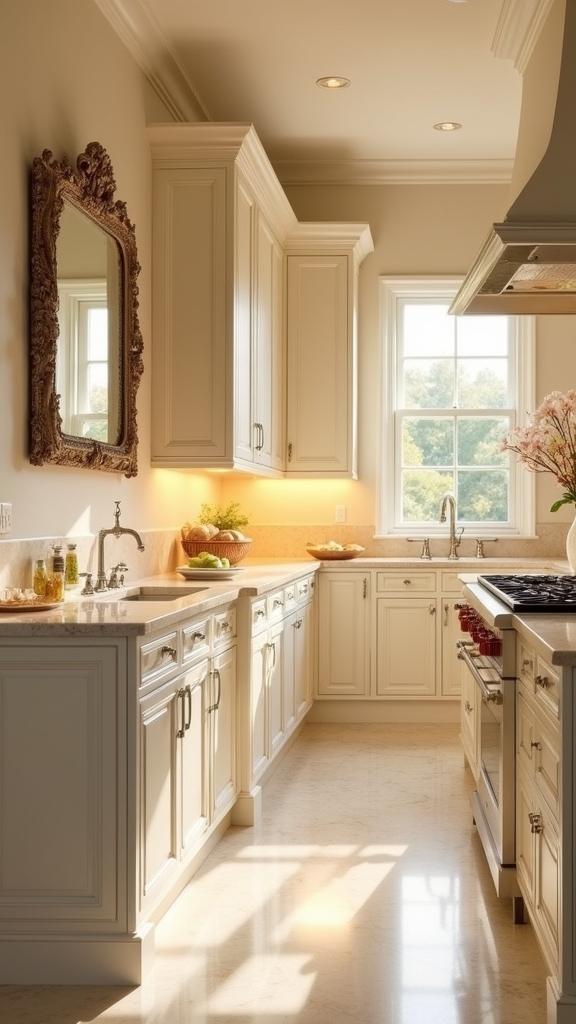
How can a cream kitchen scheme transcend its inherent warmth while amplifying spatial perception? The integration of mirrors is a sophisticated solution, utilizing reflection to expand visual boundaries and maximize ambient light.
In cream kitchens, mirrored splashbacks or cabinet panels serve dual functions: they introduce a sleek, modern counterpoint to the soft cabinetry and stimulate the diffusion of light, especially in naturally bright, south-facing rooms.
Design rationale underscores strategic placement—mirrors can create deliberate focal points, drawing the eye to curated artwork or architectural features. This interplay of reflection and illumination not only augments perceived space but also supports flexible atmospheres; dimmed lighting, when paired with mirrors, maintains intimacy without sacrificing brightness.
Ultimately, mirrors offer both aesthetic elevation and spatial enhancement within cream kitchen environments.
Cottage Cute
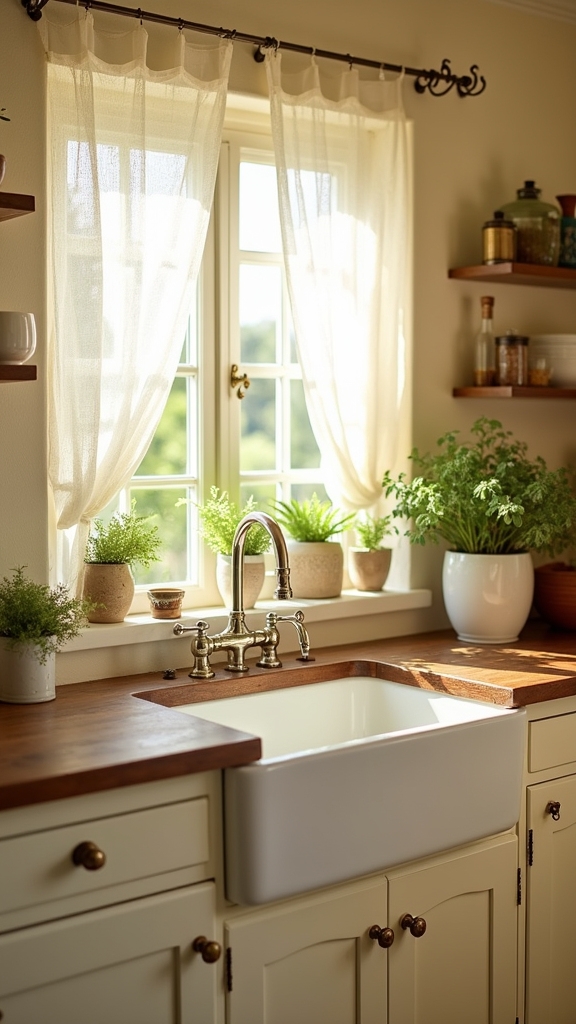
While rooted in traditional aesthetics, the “cottage cute” cream kitchen scheme leverages Shaker-style cabinetry and subtle architectural details to evoke warmth and approachability.
This approach prioritizes a warm and inviting ambiance, characterized by soft cream tones that amplify natural light for an airy, cheerful effect.
Design rationale centers on blending Shaker kitchen ideas with cozy country-inspired materials and finishes.
Key elements include:
- Shaker-style cabinetry: Timeless profiles and functional layouts foster a classic yet approachable look.
- Natural light emphasis: Cream surfaces maximize reflectivity, enhancing spatial brightness.
- Soft pastel accents: Hues like sage green or pale blue add a refined layer to the palette while maintaining a soothing environment.
- Curated vintage touches: Floral patterns and rustic wood details personalize the space with whimsical, nostalgic character.
Frequently Asked Questions
What Colours Compliment a Cream Kitchen?
Selecting colours to complement a cream kitchen involves integrating soft accent colours, contrasting cabinetry shades, bold backsplash ideas, muted metallic finishes, and natural wood tones—each contributing visual interest, balanced warmth, and nuanced depth within the overall design composition.
How to Modernise a Cream Kitchen?
To modernise a cream kitchen, experts suggest integrating sleek modern kitchen appliances, sculptural lighting fixtures, and curated cream kitchen accessories. Strategic accent wall ideas and innovative cream kitchen decor introduce visual contrast, enhancing spatial depth with a contemporary design rationale.
What Colour Flooring Goes Best With Cream Kitchen?
Selecting cream flooring options paired with warm wood tones or textured stone tiles offers cohesion and natural appeal. Alternatively, contrasting floor colours, such as charcoal or grey, introduce visual depth. Tile design choices enhance spatial perception and tactile interest.
What Color Looks Best With Cream?
When selecting complementary hues for cream kitchen accessories, cabinetry options, kitchen decor, appliances, or wall finishes, designers frequently recommend soft blues or earthy greens. These shades introduce visual contrast, highlighting cream’s warmth while preserving an inviting, balanced ambiance.
Conclusion
In conclusion, these 15 cream kitchen colour schemes exemplify the versatility and enduring appeal of this neutral palette. By integrating tonal accents—ranging from earthy tans to revitalizing mints and subtle teals—designers achieve visual balance and spatial warmth. Cream acts as an ideal backdrop, enhancing light diffusion and accommodating diverse textures and finishes. Whether channeling farmhouse charm or contemporary minimalism, these schemes demonstrate that thoughtful colour layering is fundamental to cultivating kitchens that feel both sophisticated and inviting.
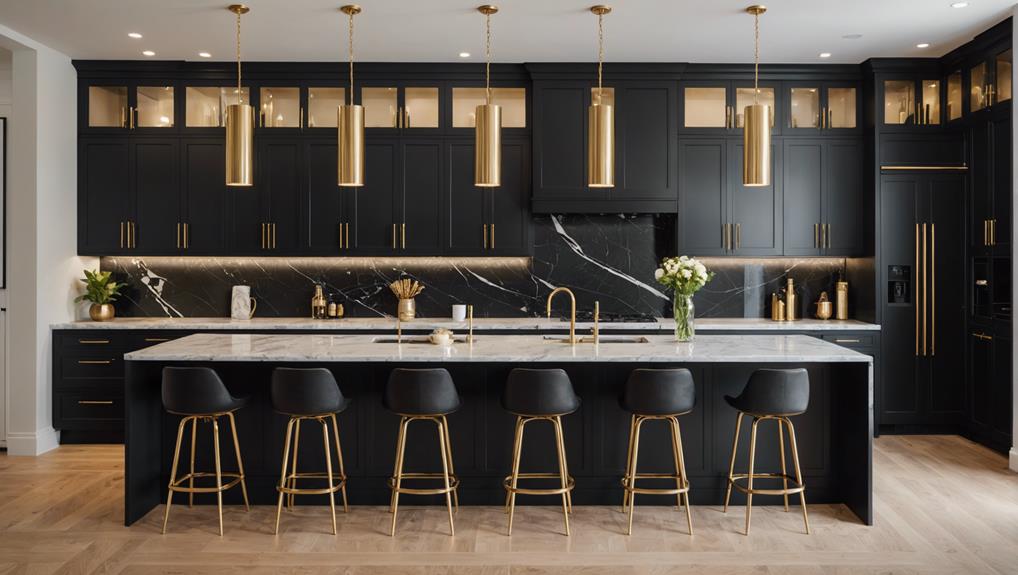
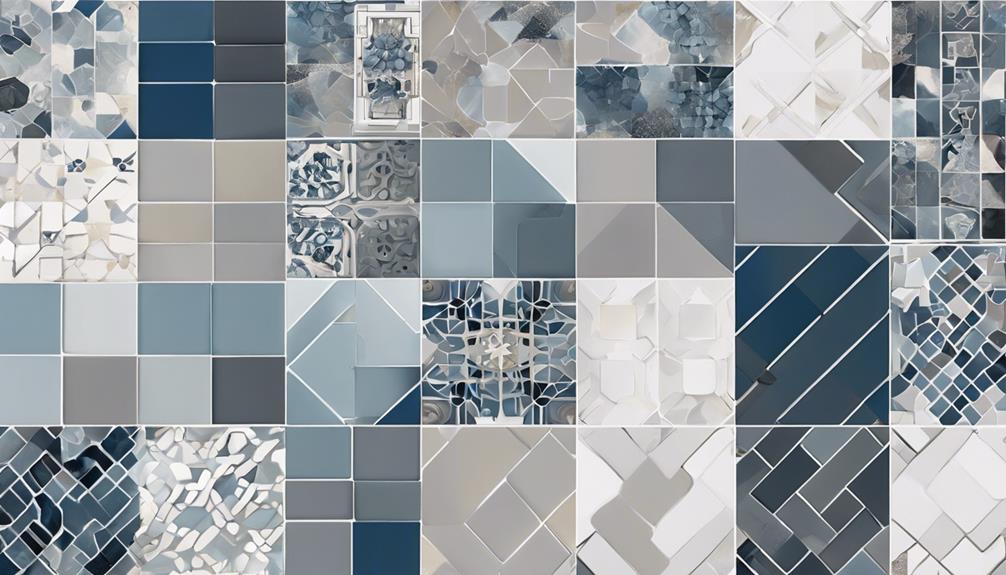
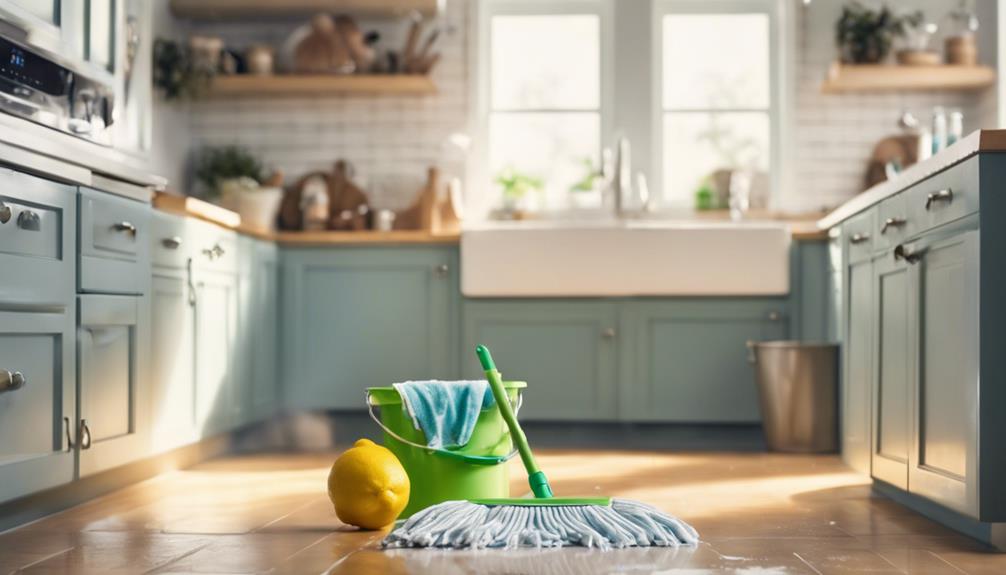
Leave a Reply